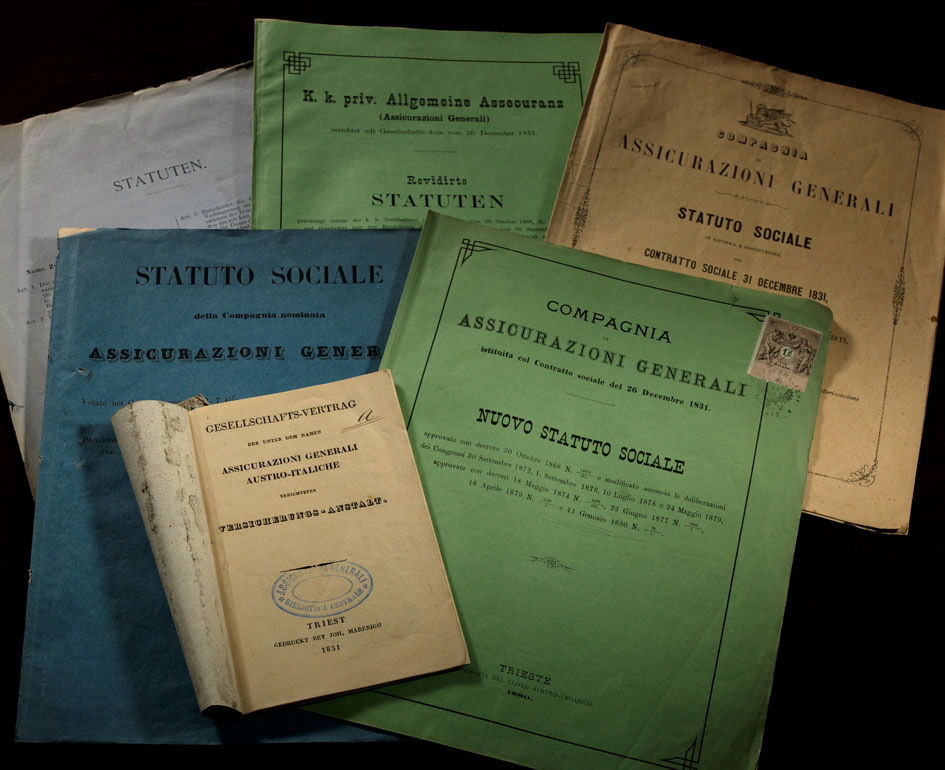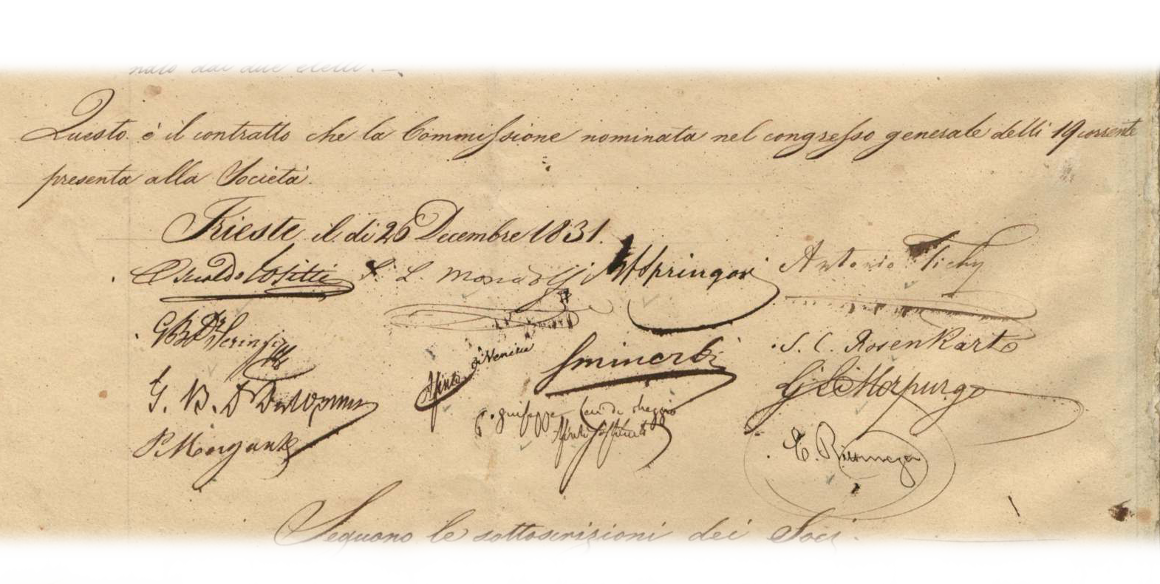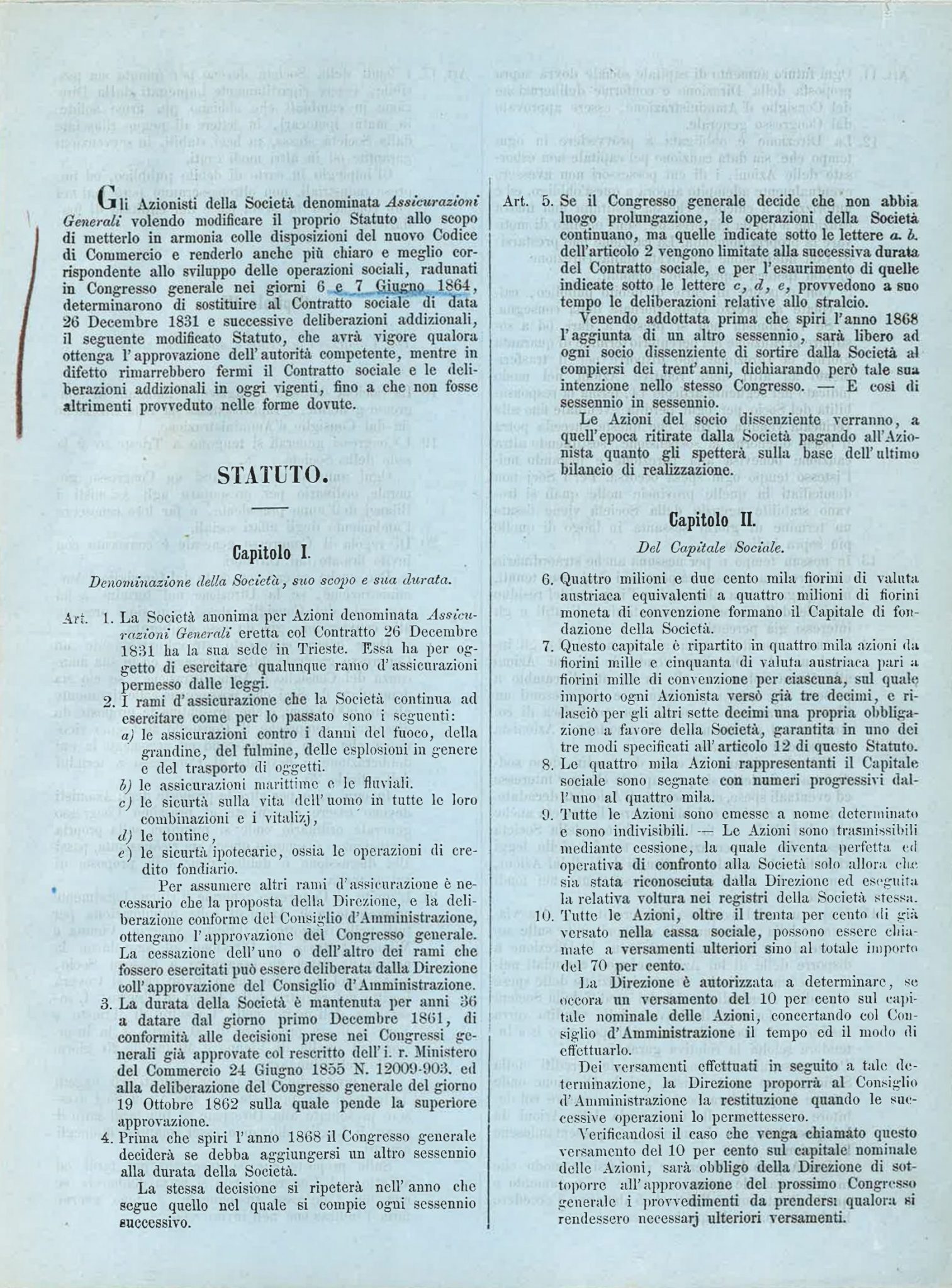Institutional Deeds: the Statutes Series of the Presidency and Corporate Bodies Fonds
01 September 2017
Statutes are undoubtedly among the most representative sources in a company’s historical archive. The juridical nature of the company statute as the founding deed corresponds to that of the social contract; that is, a contract under which a business is set up in the form of a company. Today, the constituent deed and the statute of a company are seldom identified with this statement, but for Generali social contract is one of the most important key terms in its history and identifies one of the most significant elements of its documentary heritage.
The drafting of the first social contract (also known as primitive contract, of which however no copy has been kept) was carried out by the inspector of records, Giuseppe Lazzaro Morpurgo, and was presented on November 30, 1831 at the first General Meeting of the Ausilio Generale di Sicurezza, the first constituent core of Assicurazioni Generali Austro-Italiche. The text gave rise to extensive discussions, with the consequent request for additions and modifications. On the occasion of the next General Meeting, scheduled for December 19, with a view to verifying definitively who would actually participate in the business on the basis of the proposal for revising the founding document, the persistent lack of convergence on the social contract made it necessary to establish an ad hoc commission for its final review. This commission was made up of seven members elected by the shareholders assembly (Giuseppe Levi, Antonio Tichy, Gottlieb Springer, Osvaldo Tositti, Sebastiano Carlo Rosenkart, Carlo Rittmeyer and Giovanni Battista Scrinzi), together with a censor (Sabato Levi Mondolfo) and the directors (Samuele Della Vida, Leopoldo Mauroner, Samuele Minerbi, Pasquale Morgante, Giuseppe Lazzaro Morpurgo and Giovanni Battista de Rosmini), that is, the founding members of the Ausilio itself. It was during the opening of the General Meeting on December 26 that the commission for review of the social contract presented the text in its new version, which was then definitively approved.
The text, which was written in beautiful Italian cursive on thick and numbered sheets of paper (shortly thereafter translated into German and printed in brochure form in both languages), ratified the name of the Company as Assicurazioni Generali Austro-Italiche (a name that took account of both the broad spectrum of insurance activity – open to all branches existing at that time – and the geopolitical perimeter of business and shareholding). Through 47 articles divided into eight sections, the text detailed structure and operation, deferring management of the complex relations between the Central Head Office in Trieste and the Venetian Head Office in Venice to the 1832 text of the bylaws (a very detailed text which, in addition to clarifying relations between institutional bodies, defines the operational aspects of industrial activity and agencies, as well as equity management) which is an integral part of the agreement. In closing, the list of share-subscribing members is also noted. On the basis of the sources held at the Archive, it is not possible – nor would it seem logical on the basis of historical information concerning the local context of the time – to fully attribute paternity of the first corporate statute exclusively to Giuseppe Lazzaro Morpurgo. Although the latter was actually a key figure in the history of the Company – though he died only a few years after the foundation – and even though he gave the decisive impetus to realisation of the business plan, the founders who gave life to the Management (which produced the social contract) included diverse and influential Triestine, Italian and Eastern European figures from the economic and commercial environment, all personalities with a high social profile effectively rooted in heterogeneous and professional experiences of note (interesting insights on this subject can be found in the essay by Sonia Galasso and Silvia Stener titled December 26,1831. In the Beginning There Was “Assicurazioni Generali Austro-Italiche”, published in Generali in History. Tales from the Archive. Nineteenth Century, by Marsilio in 2017). The Management could count not only on the directors of Trieste and Venice, but also the chairman, the legal consultant, the aforementioned inspector of records, the secretary-in-charge in Venice and the censors, for a total of twelve members. Approval of the social contract had to be submitted, of course, to the scrutiny of the board of directors and finally of the General Meeting of shareholders, so that this fascinating manuscript is in fact a collegially-produced documentary source. As is known, this choral nature continues to our day, as does the need for ministerial approval, which at the time came through the office of the Austrian Imperial Royal Governor of the Coastland while it is now the responsibility of the Revenue Agency. The statute encompasses the essence of the corporate structure and through the Statutes series– completed from 1831 to today, although for the moment it is presented here in partial form up to 1914 – it is possible to reconstruct the major changes in organisational structure and legal representation over the years. At the time of its foundation, the Company’s backbone consisted of the aforementioned Management, a 15-member Board of Directors, three censors and three auditors. The first set of modifications, cancellations and additions took place on the instance of the upper echelons and shareholders in the years between 1832 and 1835. The fieriest pages of the Company’s history were written in the first half of 1835: following sharp differences over the definition of the roles and responsibilities of all statutory bodies – in particular those of the chairman and legal consultant, but also the physiognomy of the Management itself – there arose the need for a clear organisational restructuring. In order to overcome irreconcilable misunderstandings on the interpretation of the original statutory provision, it was necessary to set up another ad hoc Commission for review of the social contract, again consisting of seven members (Masino Levi, Caliman Minerbi, Davide Alessio Paris, Giovanni Battista Princivalli, Pasquale Revoltella, Giovanni Guglielmo Sartorio and Giovanni Battista Scrinzi), who completed their mandate within a month. In this way, all fields and responsibilities of corporate representation were redefined, but individual modifications and additions were also made during the General Meeting following the end of the Commission’s work. A major change was, for example, the institution – by a decision adopted by the Management in 1836 – of the figure of the Secretary General, who replaced the inspector of records. This office gave shape to the more modern figure of company head, the name of which was to be changed into that of General Manager. Although the office of Secretary General became effective immediately, its existence was only transposed at the statutory level many years later, in 1851, in the form of an amendment approved by the assembly, but which did not give rise to a new version of the statute. Another significant change in corporate representation concerned the figure of the Chairman who, from his resignation as a result of dissent with the legal consultant over interpretation of the social contract, was no longer replaced and the position remained vacant until 1864. In 1848, another office of crucial importance also became vacant: that of the legal consultant. It was impossible to find a successor to the “historical” occupant of this office (Giovanni Battista de Rosmini) after his death, and it was expressly decided to leave it vacant until 1864. This was the year in which a new version of the social contract was approved, now officially a “statute” and a real milestone in Generali’s institutional history. In fact, the updates and changes made until then had simply supplemented the primitive contract, without giving rise to a really new document with statutory value. The revolutionary movements of 1848 changed the Middle-European political and economic scenario and had therefore made a truly new version of the contract necessary. Also dating back to 1848 was another significant change which demonstrates the Company’s speed of adaptation to new international scenarios: the change of name into Assicurazioni Generali; in other words, a denomination without territorial references but which maintained unaltered the nature of the activity it would continue to carry out. The statute of 1864 was the result of the work of a commission established specifically for the updating of the social contract – the third in the 19th century history of Generali – “so that [the contract] responds to the progress of the times, to the reasonable desires of the shareholders and to the eminent position achieved by our Social Establishment, and at the same time already abrogated provisions are eliminated, contradictions removed and the doubts which the many successive modifications had given rise to clarified” (protocol of the General Meeting of 19 October 1863). The text of the new Statute was approved by the members during the General Meeting of 6 and 7 June 1864 and outlined more precisely the roles and functions of both the representation and the assembly. All the changes that had occurred in the previous years and new organisational dictates were officially incorporated into a new statutory text. It received the approval of the Austrian Governor only four years later, but in fact most of the new elements came into force immediately. The figures of deputy director (three for Trieste and two for Venice) and deputy secretary (one for Trieste and one for Venice) were introduced, the office of chairman was no longer contemplated (it would be reintroduced from 1909) and the legal consultant was expressly replaced by the Secretary General. The new Statute therefore changed the composition and numerical consistency of members of the Management, which came to have thirteen members. On the other hand, the Board of Directors was reduced from fifteen to eleven members, while censors and auditors remained three for each of their respective colleges, but saw changes to their technical and administrative prerogatives and the corporate catchment area from which they were elected. In 1880, the possibility was introduced – and full advantage of which was taken from the start of its coming into force – of increasing the composition of the Board of Directors up to twenty-six members, subject to a minimum threshold of eleven members. Other changes came into force with the Statute of 1902: the number of Board members was reduced to twenty-three (but could not be lower than eight) and the figure of deputy auditor was introduced, with one to be elected for each actual auditor. In 1907, the Management came to be made up of fifteen members (a deputy director was added in Trieste and one in Venice), while the Board could have from seven to twenty-six members. In 1909, the office of Chairman was reinstated. In 1910, deputy directors were recognised as equivalent to directors and the Secretary General of Trieste and the Secretary of Venice became the General Manager and Secretary Director, both assisted by one or two substitutes, leading to a new distribution of apical responsibilities that did not give rise to any increase in the numerical composition of Management. The founding base of the Board was enlarged, and came to comprise from a minimum of seven to a maximum of thirty-one members. With the Statute of 1911, there was a further increase in the number of directors and deputies of the General Manager and the Secretary Director, and overall the Management could grow up to twenty-one members. On the other hand, the Board of Directors remained virtually stable, but the number of its members could not exceed thirty. During the first 83 years of Company activity, the 47 original articles contained in eight sections became 51 divided into seven sections: this was not a striking numerical change, but it was an expression of changes in organisational strategy and corporate vision that were as profound as they were acute. The Statutes series – and this feature is shared with the Financial Statements series – also incorporates another important corporate datum, changes in which can be followed over time: share capital. Actually, in terms that go beyond the organisational aspect, this seemingly aseptic datum takes account of the impressiveness of the means with which the Company had been endowed since the beginnings, which were far superior to those of the competitors of the time. Thanks to prudent management of business and the increments that took place over time – as evidenced by the statutes – these means guaranteed financial stability, trust by shareholders given substantial profits and guarantee funds, opportunities for growth on foreign markets and the possibility of playing a primary role in the ever-expanding insurance sector. The international vocation of the Company since its origins is also evidenced by the versions translated into several foreign languages, which were not infrequently published directly abroad in the countries of activity. A brief, but necessary, final note: the statutes are a transversal presence in different documentary series. The information on this primary corporate source extends from Management protocols to minutes of the Board of Directors and General Shareholders’ Meetings, from opinions of the Legal Office to protocols of ad hoc commissions, involved in the most delicate phases of drafting and review of the statutory decree. As in November 1831, when it all began.




